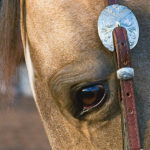Just as cars always seem to conk out when you’re miles from a service station, so tack tends to break when you’re nowhere near your barn. A busted buckle on a throatlatch isn’t a big concern, but a broken latigo or billet on the saddle puts a serious crimp in your fun.

The quick fix: Depending on the severity of the break, you may be able to string together a broken piece of your bridle with a spare strap or shoelace. Using a pocketknife, punch some holes into the leather near the break and tie the two sections together.
“I’ve also used skinny nylon ties, black electrical tape and duct tape to fix tack on the trail,” says Jamie Dieterich, a North American Trail Ride Conference horsemanship judge. “Fifty feet of nylon rope takes up hardly any room in a saddlebag, and it’s handy for repairs and many other things.” A piece of rope or a lead rope can stand in for broken reins. A destroyed bridle can be replaced by a halter with or without the bit attached to the side rings.
Saddle repairs are another matter. If a stirrup component is ruined and you don’t have an absolutely reliable replacement, you’re better off riding without stirrups than trusting your weight and balance to an uncertain setup. A broken girth/cinch part is worse still. Aside from the fact that the tack failure has probably already caused you to fall, you aren’t likely to have any sort of workable replacement. “If you have a pack animal,” says Montana wilderness rider Dan Aadland, “you may be able steal the rear cinch off of him and use it as a girth.” Without a working girth, either you ride out bareback or lead the horse home.
Prevention: Inspect and maintain your tack as if your life depended on it (it does), and have repairs made at the first signs of weakening of your saddle’s girth/cinch rigging and the bridle’s wear areas where leather and metal meet. Along with a halter and lead, carry a pocketknife or a combination tool, such as a “Leatherman.” You may also want to pack a few feet of nylon cord for on-the-spot repairs.
This article originally appeared in the August 2001 issue of EQUUS magazine.





